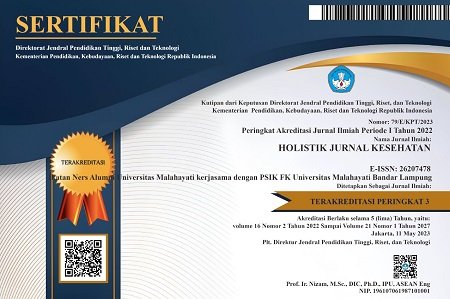Pemantauan transkutan non invasif: Co2 pada bayi dengan terapi High frequency oscillatory ventilation (HFOV): A literature review
Abstract
Background: High Frequency Oscillatory Ventilation (HFOV) is an effective breathing apparatus in infants to optimize lung volume. Continuous monitoring of CO2 is required to determine diagnosis and therapeutic evaluation. The best standard method for partial pressure measurement of carbon dioxide (PCO2) is an invasive arterial blood gas analysis. Noninvasive monitoring of transcutaneous CO2 (TCPCO2) is a well-documented, noninvasive method for tracking ventilation in newborns.
Purpose: Provide an overview and idea of the results of the literature review on non-invasive monitoring of transcutaneous CO2 in infants with High Frequency Oscillatory Ventilation (HFOV) therapy.
Method: The form ofa literatur review. database searches are carried out through Summons, Proquest dan Sciencedirect, Pub Med articles, between 2010-2023. Then filtering was carried out using PICO (Population, Intervention, Comparative, Outcome) to obtain 10 suitable articles.
Results: Based on several studies show that the most accurate CO2 monitoring is by blood gas analysis but non-invasive monitoring of transcutaneous CO2 (tcPCO2) can describe CO2 trends without repeated piercing and the results resemble venous blood gas analysis.
Conclusion: Non-invasive monitoring of tcPCO2 can be applied to monitoring CO2 in infants using High Frequency Oscillatory Ventilation (HFOV) therapy so that CO2 can be monitored continuously.
Keywords: High Frequency Oscillatory Ventilation; Infants; Non-Invasif Transcutaneous CO2
Pendahuluan: High Frequency Oscillatory Ventilation (HFOV) merupakan alat bantu pernapasan yang efektif pada bayi untuk mengoptimalkan volume paru. Diperlukan pemantauan CO2 yang kontinu untuk menentukan diagnosis dan evaluasi terapeutik. Metode standar yang paling baik untuk pengukuran tekanan parsial karbondioksida (PCO2) adalah analisa gas darah arteri yang dilakukan secara invasif. Pemantauan non-invasif transcutaneous CO2 (TCPCO2) adalah metode non-invasif yang terdokumentasi dengan baik untuk melacak ventilasi pada bayi baru lahir.
Tujuan: Memberikan gambaran dan gagasan dari hasilliterature review tentang pemantauan non-invasif transcutaneous CO2 pada bayi dengan terapi High Frequency Oscillatory Ventilation (HFOV).
Metode: Metode yang digunakan dalam penelitian ini adalah literature review. Penelusuran artikel akademik melalui Online Database pencarian melalui Summons, Proquest dan Sciencedirect, PubMed dari tahun 2010-2023. Kemudian dilakukan penyaringan dengan PICO (Population, Intervention, Comparative, Outcome) didapatkan 10 artikel yang sesuai.
Hasil: Berdasarkan beberapa studi menunjukkan bahwa pemantauan CO2 paling akurat adalah dengan analisa gas darah namun pemantauan non-invasif transcutaneous CO2 (tcPCO2) dapat menggambarkan trend CO2 tanpa penusukan berulang dan hasilnya menyerupai dengan analisa gas darah vena.
Simpulan: Pemantauan non invasive tcPCO2 dapat diterapkan untuk pemantauan CO2 pada bayi yang menggunakan terapi High Frequency Oscillatory Ventilation (HFOV) agar CO2 dapat terpantau secara kontinu.
Keywords
References
Apriana, R., & Dedy, Y. (2018). Hubungan beban kerja Dengan kepatuhan pengisian surgical patient safety checklist pada perawat di ruang instalasi bedah sentral Rumah Sakit ST. Elisabeth Semarang. Jurnal Ners Widya Husada, 3(1).
Atherton, P., Jungquist, C., & Spulecki, C. (2022). An Educational Intervention to Improve Comfort with Applying and Interpreting Transcutaneous CO2 and End-tidal CO2 Monitoring in the PACU. Journal of PeriAnesthesia Nursing, 37(6), 781-786.
Budiarto, E. (2013). Hubungan antara tekanan parsial end tidal co2 dan tekanan parsial arterial co2 pada pasien kraniotomi dengan anestesi umum (Doctoral dissertation, UNS (Sebelas Maret University)).
Chandrakantan, A., Jasiewicz, R., Reinsel, R. A., Khmara, K., Mintzer, J., DeCristofaro, J. D., & Seidman, P. (2019). Transcutaneous CO2 versus end-tidal CO2 in neonates and infants undergoing surgery: a prospective study. Medical Devices: Evidence and Research, 165-172.
Chatterjee, M., Ge, X., Kostov, Y., Tolosa, L., & Rao, G. (2014). A novel approach toward noninvasive monitoring of transcutaneous CO2. Medical engineering & physics, 36(1), 136-139.
Courtney, S. E., Durand, D. J., Asselin, J. M., Hudak, M. L., Aschner, J. L., & Shoemaker, C. T.(2002). High-frequency oscillatory ventilation versus conventional mechanical ventilation for very-low-birth-weight infants. The New England Journal of Medicine, 347(9), 643-52.
Dahliawati, Y., & Zuhroh, D. F. (2016). Perbedaan Punksi Analisa Gas Darah pada Arteri Brachialis dan Arteri Radialis dengan Kejadian Hematoma ICU Rumah Sakit Mitra Keluarga Waru. INFOKES (Informasi Kesehatan), 8(1), 9-17.
Doda, D., & Muchtar, F. (2022). Tatalaksana pasien post craniectomy tumor removal di Intensife Care Unit (ICU). Jurnal Medical Profession (Medpro), 4(3), 336-342.
Duyu, M., Mocan Çağlar, Y., Karakaya, Z., Usta Aslan, M., Yılmaz, S., Ören Leblebici, A. N., Doğan Bektaş, A., Bahar, M., & Yersel, M. N. (2021). Comparison of arterial CO2 estimation by end-tidal and transcutaneous CO2 measurements in intubated children and variability with subject related factors. Journal of clinical monitoring and computing, 35(1), 101–111.
Fuke, S., Miyamoto, K., Ohira, H., Ohira, M., Odajima, N., & Nishimura, M. (2009). Evaluation of transcutaneous CO2 responses following acute changes in PaCO2 in healthy subjects. Respirology, 14(3), 436-442.
Lermuzeaux, M., Meric, H., Sauneuf, B., Girard, S., Normand, H., Lofaso, F., & Terzi, N. (2016). Superiority of transcutaneous CO2 over end-tidal CO2 measurement for monitoring respiratory failure in nonintubated patients: a pilot study. Journal of critical care, 31(1), 150-156.
Levin, B. L., Avishay, N., Soffer, O., Arnon, S., Riskin, A., Dinur, G.,& Hochwald, O. (2023). Transcutaneous CO2 Monitoring in Extremely Low Birth Weight Premature Infants. Journal of Clinical Medicine, 12(17), 5757.
Meyers, M., Rodrigues, N., & Ari, A. (2019). High-frequency oscillatory ventilation: A narrative review. Canadian journal of respiratory therapy: CJRT= Revue canadienne de la therapie respiratoire: RCTR, 55, 40.
Miller, A. G., Tan, H. L., Smith, B. J., Rotta, A. T., & Lee, J. H. (2022). The Physiological Basis of High-Frequency Oscillatory Ventilation and Current Evidence in Adults and Children: A Narrative Review. Frontiers in physiology, 13, 808.
Mukhopadhyay, S., Maurer, R., & Puopolo, K. M. (2016). Neonatal transcutaneous carbon dioxide monitoring—effect on clinical management and outcomes. Respiratory Care, 61(1), 90-97.
Murniati, L., Taherong, F., & Syatirah, S. (2021). Manajemen Asuhan Kebidanan Pada Bayi Baru Lahir Dengan Asfiksia (Literatur Review). Jurnal Midwifery, 3(1), 32-41.
Sankaran, D., Zeinali, L., Iqbal, S., Chandrasekharan, P., & Lakshminrusimha, S. (2021). Non-invasive carbon dioxide monitoring in neonates: methods, benefits, and pitfalls. Journal of Perinatology, 41(11), 2580-2589.
Soegijanto, S. (2016). Kumpulan Makalah Penyakit Tropis dan Infeksi di Indonesia Jilid 8 (Vol. 8). Airlangga University Press.
Suwardianto, H. (2020). Buku Ajar Keperawatan Kritis: Pendekatan Evidence Base Practice Nursing. Lembaga Chakra Brahmana Lentera.
Tingay, D. G., Mills, J. F., Morley, C. J., Pellicano, A., & Dargaville, P. A. (2013). Indicators of optimal lung volume during high-frequency oscillatory ventilation in infants. Critical care medicine, 41(1), 237–244.
Veterini, A. S. (2022). BUKU AJAR Dasar-Dasar Pengaturan Alat Ventilasi Mekanik pada Pasien Dewasa. Airlangga University Press.
Zivanovic, S., Peacock, J., Alcazar-Paris, M., Lo, J. W., Lunt, A., Marlow, N., Calvert, S., & Greenough, A. (2014). Late outcomes of a randomized trial of high-frequency oscillation in neonates. The New England journal of medicine, 370(12), 1121–1130.
DOI: https://doi.org/10.33024/hjk.v17i7.12871
Refbacks
- There are currently no refbacks.
Copyright (c) 2023 Holistik Jurnal Kesehatan

This work is licensed under a Creative Commons Attribution-NonCommercial 4.0 International License.














